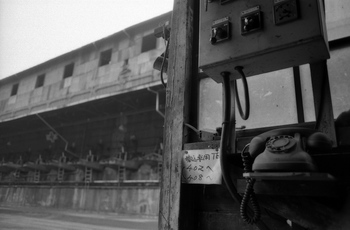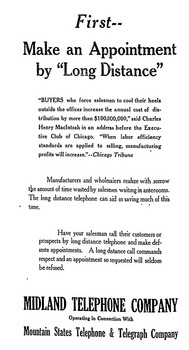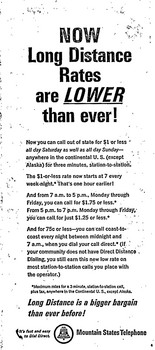Telephone Line Through Cisco [Column_Cisco Range]
 : Yanahara, Okayama, Japan
: Yanahara, Okayama, JapanCisco was truly a railroad town. It relied on the Rio Grande for its establishment and survival: I wrote before about how the town relied on the railroad for the water. But utilities other than the railroad also contributed to Cisco's survival. Here is the chronological story of how other utilities reached this remote tiny town in the desert.
Telephone Line was the first utility besides the railroad to serve the town of Cisco. It made some contribution to the survival of the town. For example, Moab residents communicated with the railroad agent at Cisco in advance to ship or travel by train from the town.
In 1911, a telephone line from Moab to Cisco was installed by La Sal Mountain Telephone & Electric Company, which was organized in 1903 by Justus(Justin) Noyes Corbin(1858 – 1923) and managed by William Jasper Meador(1865 – 1925) at that time[1].
In 1915, Corbin’s second company, Midland Telephone Company installed the line from Grand Junction CO. to Cisco and to Green River along the Midland Trail[2]. Public phones were located every mile on the telephone poles along the Trail. In 1926, Mountain States Telephone & Telegraph Company added another transcontinental phone line through Cisco[3].
In 1963, the Midland Telephone Company merged into Independent Telephone Corporation, and in 1964, ITC merged with Continental Telephone Company to form Continental Independent Telephone Corporation, which became Continental Telephone Corporation next year[4, 5].
In 1974, the Continental Telephone Corporation subsidiaries Midland Telephone Company and Utah Telephone Company merged to form Continental Telephone Company of Utah, and the name Midland finally vanished[6].
Even in the 40s, telephone at the Capansky’s was the only civilian phone in the town[7]. The phone number for the Capansky’s was "Cisco 2" according to the ad on July 21, 1955 Green River Journal. The number "Cisco 1 and 3" was obtained by Cisco Mercantile[8, 9]. The number "Cisco 2" was later succeeded by Ethel’s Cafe at least in 1976[10].
Mike Brown recalls that Cisco in 1978 might have been one of the last places in the United States without dial phones, and the phone number for by that time Cisco Desert Sun Inn, former Ethel’s Cafe, was "Cisco 8"; the situation in the 70s was nothing changed from the case declared on April 16, 1925 Midland Telephone Company Ad[11].
revised, Jun. 4, 2020
revised, Aug. 1, 2021
revised, May 16, 2022
[1] Sep. 22, 1911 Grand Valley Times;
[2] Sep. 21, 1915 Daily Sentinel;
[3] Jul. 29, 1926 Times-Independent;
[4] Dec. 12, 1963 Times Independent;
[5] Palmer, Jay, (1999) "May I Have Your Nunmer, Please?", Vol. 37, Canyon Legacy, Dan O'Laurie Canyon County Museum
[6] Jan. 17, 1974 Tremonton Leader;
[7] Mary L. Hepperle, (2004) "Memories of Cisco", Canyon Legacy, vol. 51, Dan O'Laurie Canyon County Museum;
[8] Nov. 16, 1947 Daily Sentinel;
[9] Sep. 19, 1966 Daily Sentinel;
[10] Oct. 7, 1976 Times-Independent;
[11] Brown, Mike (2014) "127 thoughts on 'A Conversation That Actually Just Happened'", Whatever;


left: Apr. 16, 1925 Times Independent, right: Jan. 19, 1968 Ephraim Enterprise
Ciscoはその盛衰を鉄道に左右された町だったといえるだろう。しかし、鉄道以外のインフラストラクチャーの進展がこの町の盛衰に果たした役割も少なくない。ここでは、それらがどのようにこの地の果てのような荒野のただ中にある町に進展してきたか、紹介する。
鉄道・道路以外のインフラストラクチャーで、この町に最初に進展してきたのは電話回線である。1911年には地域の中心であるMoabの町とCiscoを結ぶ回線が整備されている。専ら、Moab の住人がCiscoからD&RGWに乗車・出荷するにあたって、駅員に連絡するために用いられたようだ。
その後、1940年代においても、駅以外で電話を引いていたのは、以前紹介したCapansky氏のカフェだけだったようだ。ちなみにCapansky氏のカフェの電話番号は「2」。1978年の訪問記には、当時唯一営業していたカフェであるCisco Desert Sun Innに引かれていた電話が、全米でも最後の手動式回線による電話のひとつとして紹介されている。ちなみにその電話番号は「8」だったようだ。
2017-01-20 09:00
コメント(0)




コメント 0